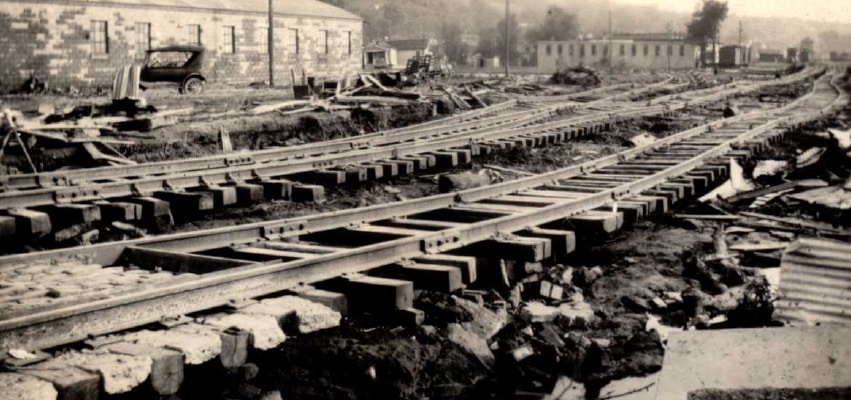The rain began to fall at about noon almost 95 years ago to the day — May 18, 1927.
The ground was already saturated from the precipitation of the day before. Over the next six hours, 5.5 inches of rain would land on central lllinois – reportedly double that in some spots – from a storm 15 miles wide and 75 miles long.
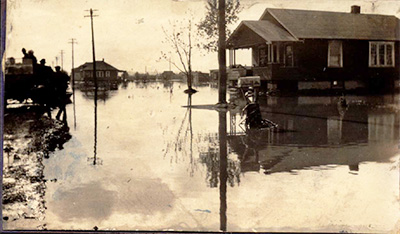
Some 500 million cubic feet of water from 55 square miles of watershed would empty into Farm Creek, which overran its banks. As the water rose, the current would reach a speed three times that of the lllinois River, fed by that same Farm Creek.
In downtown East Peoria, they heard the flash flood coming before they actually saw it. Claude Hinton was among the first. He jumped in his car and drove down Washington Street, then Center, then Edmund, trying to warn his neighbors. “Flood, flood!” he shouted. Few paid any heed. The water would never reach the top of the levees and they would hold. They always had.
Eldon Kauffman, writing for the Peoria Morning Star, put it this way:
“A six to 15 foot wall of ravaging, tearing, coffee-brown water gathered in tiny, tame little Farm Creek from the spewing hillsides and like an invading horde of savages destroyed…everything in its path.
“Tons and tons of debris – trees, buildings, dead animals – gathered before the flood, tearing out three bridges, flooding the city three feet deep at the four corners and 20 feet deep near Edmund Street …”
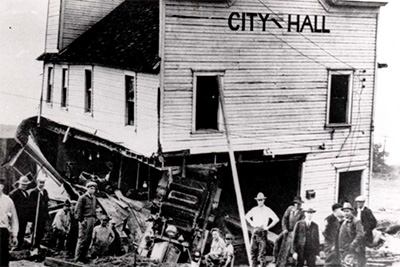
East Peoria’s City Hall collapsed. Local residents took refuge on their roofs, including 27 schoolchildren who spent four hours atop one until rescue personnel could reach them. Some 400 homes had to be evacuated, and 300 vehicles were swept away. There were differing reports regarding casualties, but ultimately an unidentified baby was discovered lifeless after the waters receded, and 66-year-old George Mariner was electrocuted when a boat he was riding in was driven by a wave into a live wire.
As for East Peoria, the flood produced the “most tragic night of its existence,” according to the newspaper account. The city would be “scarred for years.”
While it was a far cry from Pennsylvania’s historic Johnstown flood that would take the lives of more than 2,200 people, what local officials had witnessed was bad enough and they vowed that a flood of that magnitude could never be allowed to happen again.
Millions of dollars were spent over the next 20 years to deepen and straighten Farm Creek, and a new diversion channel and spillway were built. Yet the flooding continued.
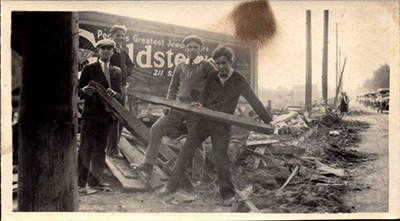 In 1943, the Illinois River crested at a then-record 28.82 feet. Factory workers, schoolboys, store clerks and other volunteers worked round the clock over three days of sandbagging to reinforce and raise the levees to protect the industries – and the jobs therein – along the waterfront. President Franklin D. Roosevelt himself would take notice, praising the effort in one of his fireside chats.
In 1943, the Illinois River crested at a then-record 28.82 feet. Factory workers, schoolboys, store clerks and other volunteers worked round the clock over three days of sandbagging to reinforce and raise the levees to protect the industries – and the jobs therein – along the waterfront. President Franklin D. Roosevelt himself would take notice, praising the effort in one of his fireside chats.
The water came just inches from topping the levee, and enough was enough.
In 1949, work began on the construction of two dams – the Fondulac Reservoir Dam in East Peoria and the Farmdale Reservoir Dam about three miles east of town — at a then-cost of $8 million, nearly $100 million in 2022 dollars. The latter, an earthen dam with a six-foot diameter tunnel at its base, towers 80 feet above the creek bed below and is nearly 1,300 feet long. With any significant rain, the water backs up, creating an instant lake behind it that can reach 400 acres in size. Most of the time, however, that area is dry.
When the dams were completed in 1951 – the general contractor was Acme Construction of Cleveland — it was said that they could withstand “anything that will ever be thrown at it.” In the more than 70 years since, that has largely proven to be true. Downtown East Peoria has been spared ever since by that one-two defense.
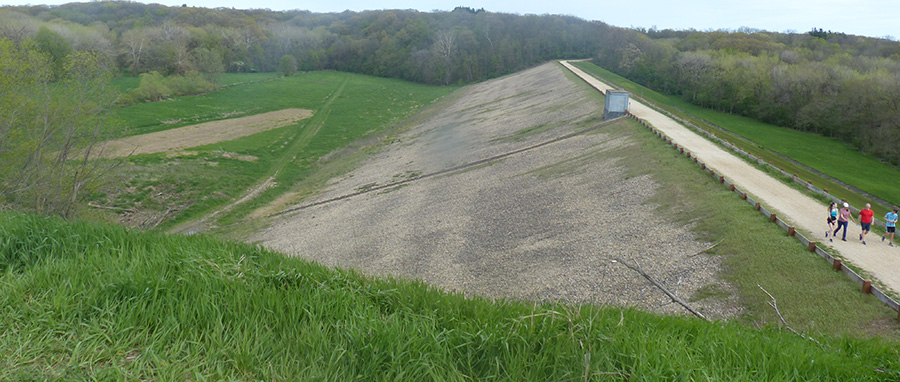
Today that easternmost dam also is home to Farmdale Reservoir Park, 837 acres of tall grass prairie, oak and hickory woodland, abundant wildlife and 1.5 miles of stream managed by the U.S. Army Corps of Engineers. With some 15 miles of trails contained therein, it is one of central Illinois’ most unique spots for hiking, biking, horseback riding, geocaching and cross-country skiing.
All in all, it has been a pragmatic and popular solution, making the best of what was once a very real and potentially life- and property-threatening problem.
* Information for this story was pulled from the old Peoria Morning Star, with the help of the Peoria Public Library and East Peoria’s Fondulac District Library. The U.S. Army Corps of Engineers’ Farmdale Reservoir website also was an important resource.



